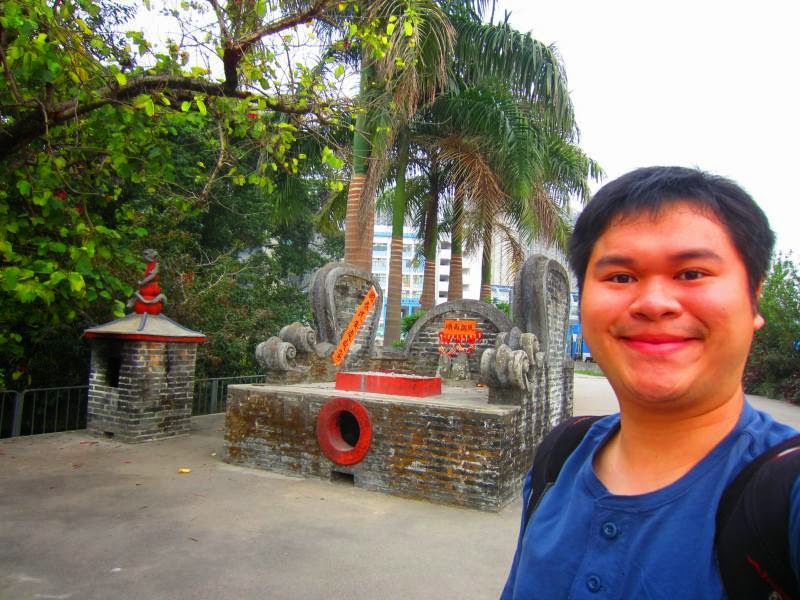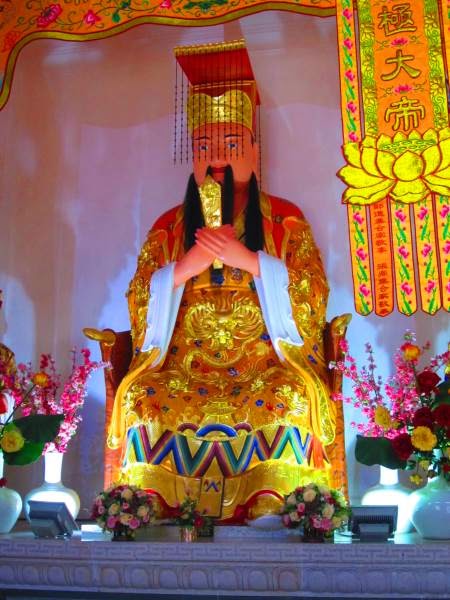- March 16, 2014, Sunday
- I woke up earlier than usual since I was in for a really long day. I headed to Hong Kong's New Territories, a not-so-explored area of Hong Kong. A lot of people don't go there, so much so that not a lot of Hong Kong people know about it, or even if they do, not many of them have gone there. Fewer foreign tourists visit the New Territories since they are probably interested in the main and usual things offered by Hong Kong (i.e. shopping, theme parks, more shopping, etc.) I was, of course, interested in Hong Kong's pre-colonial past, to understand more about Hong Kong's history and culture. Had I more time in Hong Kong, I would have wanted to visit Hong Kong's colonial heritage trail - I'll save that for another time though.
- I first visited Kat Hing Wai, an old walled city dating from the Ming Dynasty. The houses inside Kat Hing Wai are now modern houses, with some of the brick buildings remaining. As most, if not all walled cities, it also had a village/"city" temple. The Kat Hing Wai is home to Hakka people, and during the day, women with their black hakka hat would stay near the gate of the walled city for photo ops; small donations were expected. When I went there, it was really early, and the women with the hats were still probably sleeping, so I didn't see any of them. I did see one random street sweeper with that hat though, but not near Kat Hing Wai.
 |
| Kat Hing Wai. |
 |
| A shrine inside the temple. |
- After paying a visit to Kat Hing Wai, I set off on a journey to the Pingshan heritage trail near Tin Shui Wai MTR. The Pingshan heritage trail is a homage to the Tang clan who inhabited these villages since the Yuan Dynasty. Some of the old structures have been preserved, and are the, of course, the points of interest that make up the heritage trail.
 |
| Ping Shan Heritage Trail. |
- The structure nearest to the MTR was the three-story Tsui Shing Lau Pagoda, and the oldest pagoda in Hong Kong; it was built in the 1400s.
- The Shrine of the Earth God ("She Kung") was located not too far from the pagoda, and could be easily missed since it was a small structure at the side of the road. The Earth God was meant to protect the village. People still give offerings to the Earth God, to allow him to continue protecting the village.
 |
| Not a big shrine. Haha. |
- The Sheung Cheung Wai looked similar to the Kat Hing Wai, and is also inhabited by people living in modern houses inside the ancient wall. A small temple was also located inside.
- Right past an ancient well is the Yeung Hau Temple, dedicated to Hau Wong (like the one in Kowloon.) Apart from Hau Wong, She Kung, and Kam Fa (Goddess of Expectant Mothers) statues were also there.
 |
| Old well. |
- Further on, two ancestral halls were located right beside each other. The Tang Ancestral Hall and Yu Kiu Ancestral Halls looked very identical, and each had a shrine inside for the deceased.
 |
| Roofs. |
 |
| Pitcher plants!! |
- Another pair of structures were next in the trail: the Kun Ting Study Hall and the Ching Shu Hin hall. Both structures were made during the Qing Dynasty. The Kun Ting Study Hall also served as an ancestral hall apart from being a study. It also has a side door that leads to the Ching Shu Hin hall. The Ching Shu Hin hall used to be a guesthouse for scholars and upper-class men. My favorite part of Ching Shu Hin was its moon gate with superb lighting for silhouette photoshoots (when taken from the inside.)
 |
| Kun Ting Study Hall. |
 |
| Ching Shu Hin's moon gate. |
 |
| Yes that's me. |
 |
| Other side of the moon gate. |
 |
| Fan dance. |
 |
| Outside the halls. |
- I went to the Hung Shing Temple after the Kun Ting Study Hall and Ching Shu Hin. It was a small temple built in the 1700s by the Tang clan, and is located near a tiny park.
- Finally, I got lost looking for the Ping Shan Tang Clan Gallery, a small museum about the Pingshan Heritage Trail that was made from the old Ping Shan Police Station. It was located on top of a hill; one side of the hill was filled with memorials/tombs, probably of the clan members. I realized that it was better to start from the gallery and end with the pagoda instead of my route, because the gallery/museum provided a good background of all the places in the trail; also, I realized that I missed the entrance hall of the Shut Hing Study Hall, which wasn't located in the primary map I was using (it was in my second Ping Shan map though.)
 |
| Wedding garb inside gallery. |
 |
| "Tang." ("Deng" in Mandarin.) |
 |
| Old police station. |
- I went back to see the entrance hall of the Shut Hing Study Hall, getting lost on the way. It was hidden within some houses, and I had to ask two people for directions. Good thing I understood their Cantonese, since I don't really have a deep background on Cantonese; I can speak some functional Cantonese, but I can't engage in a deep conversation with the language.
 |
| Hidden among houses. |
 |
| Such detail. |
- I had a quick lunch inside the train (despite not being allowed to eat inside the train, but I was too hungry to not eat.) I was on my way to the next heritage trail for the day - the northern Fanling Heritage Trail, also known as the "Lung Yeuk Tau Heritage Trail" (Mountain of the Leaping Dragon.)
 |
| This was the map that I used. |
 |
| This, I think is a more complete map, but the route was more difficult to follow. |
- One exit of the MTR leads to the Fung Ying Seen Koon, a large temple complex with many ancestral halls. It also has a vegetarian restaurant, and a lot of prayer halls.
 |
| Fung Ying Seen Koon. |
 |
| Taoist/Buddhist devotees. |
 |
| Hmmmm. |
 |
| Year I was born. |
 |
| My supposed guardian. |
- At the other side of the Fung Ying Seen Koon exit is the Fanling Town Centre, a small mall located near the Fanling residential area. The walk to the main heritage trail was quite far, and the closer I was to the heritage trail, the less people I saw. Too the point that I was perhaps the only person walking as far as my eyes could see. The heritage trail was close to the Ma Wat River, and more plants surrounded me.
- I first saw the Shung Him Tong (aka "Tsun Kyam Church,") made by Hakka Lutherans. Near the church was the now-plant-covered Shek Lo, a building made in 1925 by Mr. Tsui Yan Sou, founder of Wan Yan College. Just like most upper/upper-middle class architecture of that time, it was a blend of western and Chinese architectural styles.
 |
| Shek Lo. |
- The next part of the trail was a visit to Ma Wat Wai and Lo Wai, both walled cities in the trail. The looked like smaller versions of the Kat Hing Wai walled city and Ping Shan's Sheung Cheung Wai. However, Ma Wat Wai and Lo Wai were not open to the public apart from the residents of those walled cities. Probably because the cities/villages were small too.
 |
| Ma Wat Wai. |
 |
| Lo Wai. |
- The final part of Fanling's main heritage trail was the Tang Chung Ling Ancestral Hall, and the Tin Hau Temple right beside it. The Tang Chung Ling Ancestral Hall was built around the 1500s. While the Tin Hau Temple was built much later on.
- Fanling has around six more places after the ancestral hall and Tin Hau Temple, but I decided not to visit them because they were too far, and it was a bit difficult to navigate within Fanling; Fanling beyond the busy residential areas near the MTR seemed like a ghost town. Compared to the Ping Shan Heritage Trail, fewer people came to do this heritage trail, usually individuals, some cyclists, or some locals who wanted to see a quieter and a more rural side of Hong Kong.
 |
| A woof on the roof. |
 |
| Tin Hau Temple. |
 |
| Old bells. |
- I finished my tour early, around quarter past 3pm. I had a late and more "proper" lunch at KFC in Fanling Town Centre, before I decided to insert another destination I was saving for another day. It was on the way home anyway, and I had a lot of time to spare.
- I stopped by Shatin MTR station to visit the Ten Thousand Buddhas Monastery (Man Fat Tze;) it's more of a temple than an actual monastery. It was made in 1951, and literally has 10,000 or more golden Buddhas in all shapes and sizes. There were also a thousand Buddha-lined steps leading to the peak of the mountain, with some benches and sheds for resting along the way. There was also a mid-level open area with, unsurprisingly, more Buddhas, and a vegetarian restaurant.
 |
| The Buddhas start to greet people from the moment people go up the slope. |
 |
| Main entrance. |
 |
| Too many stepsss. |
 |
| A big Buddha. |
 |
| A fat reclining Buddha; the usual reclining Buddhas are not fat. |
 |
| Guan Yin. |
 |
| Doing some taichi. |
 |
| "Namo Amitabha" (Nanwu Amituofu.) |
 |
| She has a loooot of hands (Thousand-Hand Guan Yin.) |
 |
| Boy he has a really reaaaaaaaaaaaaaally long arm. |
- Funny things happen to me when travelling. This time, on the way out of the temple, still in my costume, two groups of people approached me in separate instances, to have a photo with me and my costume. To their surprise, I was Filipino, and to my humor, both groups were Filipinos - one mormon group visiting Hong Kong, and another bunch of domestic helpers on their day off in Hong Kong.
- At the end of the day, I celebrated my heritage trail success by having a Nepalese dinner in Manakamana, Temple Street. I also did some shopping, finally.
 |
| I miss Nepal!! |




















































































































No comments:
Post a Comment